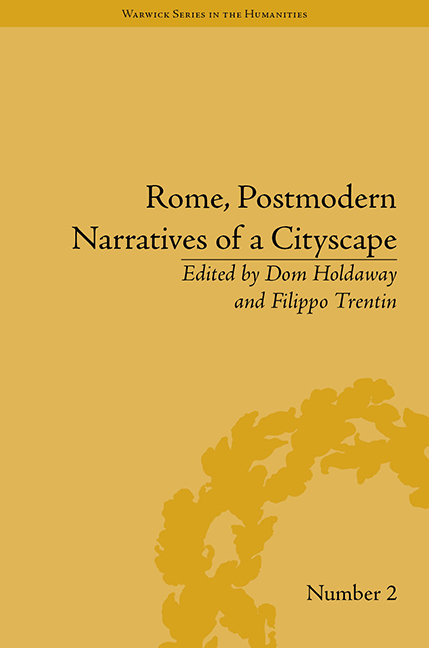Book contents
- Frontmatter
- Contents
- Acknowledgements
- List of Contributors
- List of Figures
- Introduction: Rome, Postmodern Narratives of a Cityscape
- Part I Knowing Rome
- Part II Fragmented Topography
- Part III Situating Rome
- 7 Ecclesiastical Icons: Defining Rome through Architectural Exchange
- 8 ‘Roma Interrotta’: Postmodern Rome as the Source of Fragmented Narratives
- 9 Las Vegas by Way of Rome: The Eternal City and American Postmodernism
- Notes
- Index
9 - Las Vegas by Way of Rome: The Eternal City and American Postmodernism
from Part III - Situating Rome
- Frontmatter
- Contents
- Acknowledgements
- List of Contributors
- List of Figures
- Introduction: Rome, Postmodern Narratives of a Cityscape
- Part I Knowing Rome
- Part II Fragmented Topography
- Part III Situating Rome
- 7 Ecclesiastical Icons: Defining Rome through Architectural Exchange
- 8 ‘Roma Interrotta’: Postmodern Rome as the Source of Fragmented Narratives
- 9 Las Vegas by Way of Rome: The Eternal City and American Postmodernism
- Notes
- Index
Summary
The postmodern movement questioned master narratives that purported to convey eternal truths. Identified by Jean-François Lyotard for its scepticism towards metanarratives, or comprehensive explanations of history, postmodernism would seem to have little to do with the idea of Rome as locus of universal value: the eternal city. In architectural culture, this idea originated in the grand tour of the seventeenth and eighteenth centuries and persisted through the nineteenth and twentieth centuries in the Grand Prix de Rome of France's architectural academy and in schools modelled on the French system. With the establishment in 1720 of the annual Grand Prix de Rome by the Académie Royale d'Architecture, the predecessor to the École des Beaux-Arts, a pilgrimage to Rome to experience the city's glories at first hand became the culmination of architectural education. Prevailing for two hundred and fifty years, this continuum came to an end in 1968, following the student revolts that transformed architectural education in France. The permanent termination of Grand Prix competitions reflected modernism's radical break with history and seemed to signal the dénouement of Rome as wellspring of architectural influence.
Yet Rome was inconvertibly a touchstone for two of America's most important postmodern architects: Charles W. Moore and Robert Venturi. In this essay, I discuss the significance Rome held for each of these architects and the differences that mark the lessons they learned from the Italian capital.
- Type
- Chapter
- Information
- Rome, Postmodern Narratives of a Cityscape , pp. 171 - 188Publisher: Pickering & ChattoFirst published in: 2014



